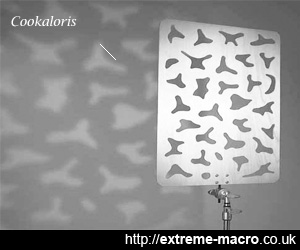Flash Flag
by Johan J Ingles-Le Nobel
Last updated August 31, 2017
A flag is simply something that blocks or partially blocks a light source, in order to alter the intensity of the light falling on the subject.
I use flags all the time in extreme macro studio work, and to a lesser degree in field work as well. With a flag, you can always shine too much light on a subject and reduce it manually this way, whereas if you don't have enough light there's not too much you can do.
Using A Flag
One of the core concepts of lighting is that it's better to have too much of it than too little. That's because we can always use flags to lessen light, but it's not always possible to increase light easily. This is a major concept to keep in mind especially for macro where we often don't have enough light.
better to have too much light than too little - you can always take awayFlags are just as useful with diffused light as they are with direct light. I often add a layer of clear laminating paper above my diffusion medium, and then before making the shot use a flag on a paddle to test where I need to stick a small flag onto the laminating sheet before shooting.
This isn't exactly a costly or sophisticated exercise. By a flag on a paddle I mean a straw with a bit of black card attached to the end, and by a flag on the laminating paper I literally mean just a piece of black electrician's tape cut to size.

Cookaloris lighting flag, a variant of a simple flag. This is a flag with shapes and patterns and can be useful to make the background a bit more interesting if you're using paper or any other solid planar surface.
You might also go even fancier and make a gobo, which is the same idea as a cookaloris but placed at the point of focus so that there are sharp edges in the final result. Ie think silhouette.
Flag Variants
Whilst a flag is just a simple block, you can actually go a bit further and use the same concept and make various other things which are also helpful. By cutting shapes into your flag it is possible to vary the light intensity and create patterns, known as a cookaloris or cookie.
This can be useful to make the background a bit more interesting if you're using paper or any other solid planar surface. You might also go even fancier and make a gobo, which is the same idea as a cookaloris but placed at the point of focus so that there are sharp edges in the final result. Ie think silhouette.
Other variants I also employ are semi-translucent flags. In other words, instead of it being a binary exercise, you only block some of the light, which again gives better control.
In extreme macro it is always recommended to use a lens hood to prevent unwanted light from hitting the lens. Adding some extra flags to achieve the same end isn't the worst idea in the world.
Flag Use
The shadow line's sharpness depends on the size of the flag, the sharpness of the light (ie direct, indirect or diffused), and the distance from the flag to the shadow. Beyond this it's all about trial and error.
Courtesy Flag
This is probably my favourite flag of all! When you're working away at extreme macro stacking, the last thing you want is to be blinded by the flashes all the time.
Just make yourself some courtesy flags - an obstruction between your flash and you so that the damn flashes don't blind you all the time! Thick pieces of card attached onto the flash with blutack usually do the trick.
Related Articles



